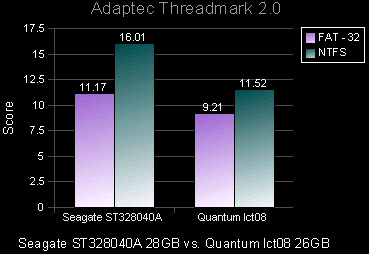Threadmark 2.0

Performance
Analysis
From the scores seen above and on
the previous page, it is clear that the ST328040A leaves the Quantum lct08 far
behind performance wise. Though both drives do operate at different rotational
speeds, the objective of this comparison was to bring to light the performance
advantages of a 7200rpm drive over a 5400rpm type. And the results do show such
benefits of a 7200rpm drive. As I am used to using a 5400rpm drive for
my personal use, it was certainly a wonderful change when loading up applications
(and the NT OS) using the Barracuda.
Various programs took just about no time to load and I never in my
life have seen Windows NT load so fast! Sure, the Quantum lct08 is certainly a
pretty fast drive, no doubt, but regular usage of the Seagate provided the
testimonial of its performance. Frankly, I was pretty amazed.
CPU
Utilization was at its lowest under Windows NT. Naturally, one would expect this
from such a robust operating system. Another good thing was that the Barracuda
actually reported access times (under the Winbench Disk Inspection Tests) very
close to manufacturer specifications. More specifically, the access time
reported under this test was 8.56 under Windows 98 (FAT16) and 8.54 under
Windows NT (NTFS) as against the 8.0ms rating given to us by Seagate. Access
time was pretty high under Windows 98 with a FAT32 partition with an average
access time of just over 14ms.
Okay, so we have already
seen that the Barracuda is a really fast drive. What about the known
disadvantages that come with 7200rpm drives? Well, here we
go...
